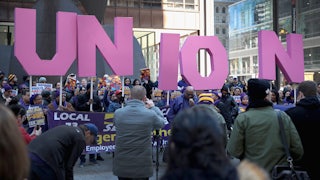Ballots were mailed out starting last Friday over whether Amazon’s Bessemer, Alabama, warehouse will become the first Amazon unit to unionize. The ballots will be counted starting March 28. The union will probably lose; the Retail, Wholesale, and Department Store Union polled less than 30 percent in an earlier vote last spring.
The National Labor Relations Board ordered that the earlier election be rerun because of a dispute over a ballot-collection box that management installed in the parking lot against the union’s wishes. The mailbox has now been moved to another location on the property, which may or may not make a difference, but the last vote was so lopsided that a union victory would be very surprising.
What happened last year in Bessemer is, unfortunately, the rule. Breakthrough victories like the recent unionization of two Starbucks cafés in Buffalo, New York, are the exception. It’s simply too easy for management to bully employees into rejecting labor representation. On Tuesday, Starbucks fired what the workers described as “virtually our entire union leadership” at a Memphis store for airing their grievances to a local news broadcaster after closing time. The impunity was astonishing. But the most shocking part is that the firings weren’t necessarily illegal (though they may have been).
The sad truth, as Michigan’s Representative Andy Levin, himself a former union organizer, told The New York Times last year, is: “Workers cannot organize to scale in America absent labor law reform, full stop.”
That statement is so manifestly true that I’m going to repeat it.
“Workers cannot organize to scale in America absent labor law reform, full stop.”
You now understand the gloomy frame of mind in which I read the Biden administration’s new task force report on worker organizing and empowerment. The report catalogs various ways the administration can encourage unionization. But the depressing truth that the report, to its credit, kind of acknowledges is that there’s little of much significance that President Biden can do outside the public sector without passing some or all of the Protecting the Right to Organize Act, which cleared the House, 225–206, almost a year ago but is stuck in the Senate because the Democrats don’t have the votes to beat a Republican filibuster.
The preamble to the 1935 National Labor Relations Act, labor activists never tire of saying, declares it to be the policy of the United States “to eliminate the causes of certain substantial obstructions to the free flow of commerce … by encouraging the practice and procedure of collective bargaining.” In effect, the preamble says that the absence of a labor union makes it harder to do business, or anyway to do business the way we’d like to see it done.
This has not been a talking point in recent decades even for most liberals, but Biden says it a lot, and so does a fact sheet accompanying the report. The fact sheet also says “no previous administration has taken a comprehensive approach to determining how the executive branch can advance worker organizing and collective bargaining.” That’s a large claim, one that perhaps discounts President Franklin Roosevelt’s famous refrain, “Clear it with Sidney” (Sidney being Sidney Hillman, president of the Amalgamated Clothing Workers Union). But certainly no administration has done it in my lifetime, and, well, let’s just say I don’t get carded when I buy liquor.
How much can a Democratic president do to help labor unions without an assist from Congress? For Biden himself, the boldest instance was to essentially side with the Retail, Wholesale, and Department Store Union and against Amazon management in last spring’s Bessemer vote, as I noted at the time. It didn’t work; the union lost. The boldest and most important recommendations in the new report, which, because the task force was chaired by Vice President Kamala Harris, are really directives, address union issues for federal workers and federal contract workers.
Biden has already reversed some agency-specific policies, many imposed by President Donald Trump, that impeded union activity for government workers. Now his task force is directing the General Services Administration, or GSA, to implement policies granting union organizers greater access to federal property government-wide. The Pentagon and the Department of Health and Human Services are being instructed to examine possible job misclassifications that exclude certain workers from bargaining units. And the Department of Homeland Security will do what it can to expand bargaining rights for employees at the Transportation Security Administration, which were sharply restricted in the post-9/11 legislation that created the TSA.
As of January 30, federal contract workers must be paid at least $15 an hour under an executive order Biden signed in April that was finalized by the Labor Department in November. The Economic Policy Institute, a left-leaning nonprofit, estimated that the number of workers who got a raise when it took effect last month may have been as high as 390,000. That’s a substantial accomplishment. The report further directs GSA to expand unions’ access to federal contract workers when those workers perform their jobs on federal property. It also directs the Federal Acquisition Regulatory Council, the National Labor Relations Board, and the Federal Labor Relations Authority to lean on federal contractors that drag their feet on reaching a collective bargaining agreement with unions that represent their workers.
The federal government doesn’t have a lot of leverage over how employers treat private-sector workers, and the new report reflects that. Its instructions are worthy but not hugely significant. The Labor Department is instructed to improve its reporting of activities undertaken by union-busters and to keep closer track of which companies hiring such “persuaders” are federal contractors. The Pentagon is instructed to clarify rules forbidding contractors from billing the federal government for union-buster services. Most of the other provisions for private workers entail making workers better aware of their labor rights.
What really needs to happen is that the PRO Act needs to pass. As the report notes, the PRO Act “would curb the anti-union, anti-worker excesses of the Taft-Hartley Act.” Passed in 1947 over President Harry Truman’s veto, the Taft-Hartley Act restricted union organizing in various ways and for the first time allowed states to declare themselves “right to work” jurisdictions where union nonmembers were no longer required to pay union fees to cover their share of collective bargaining. Taft-Hartley is the labor movement’s great white whale. Liberals have been trying to harpoon it since its enactment by a Republican Congress amid national panic over the inflationary effects of labor unions’ pent-up postwar wage demands. (In fairness, about half the Democratic caucus, mostly from the South, joined Republicans to override Truman’s veto.) The law is why union density in the U.S. began to decline in the mid-1950s, and it’s the biggest single reason that labor is so pitifully weak today in comparison to labor movements in other Western economies. But Democrats have never been able to roll it back. Not even President Lyndon Johnson, during liberalism’s Great Society zenith, could find the votes to repeal Taft-Hartley.
The PRO Act would eliminate Taft-Hartley’s right-to-work free ride, which drains union treasuries. It would expand boycott rights for striking workers, which were curbed under Taft-Hartley. It would restore, to some extent, the “card check” option for union elections, which before Taft-Hartley didn’t require approval from management. It would also strengthen certain provisions in the National Labor Relations Act. Most notably, it would allow the NLRB to impose much more serious penalties on companies that violate the law. (For more on that, see my piece in TNR’s January issue, “The National Labor Relations Board is Finally Doing Its Job.”)
The boosted NLRB penalties were included in the Build Back Better Act, which is dead for the time being. But the NLRB provision drew virtually no attention from critics of the bill, suggesting that Senate Appropriations Committee Chairman Bernie Sanders can safely attach it to some future reconciliation bill (which, unlike other bills, can’t be subjected to Republican filibuster). My guess is that, being Bernie, he will.
Eventually the filibuster itself, which has been dying in stages for more than a decade, will receive the final death blow it so richly deserves. That probably won’t happen while Biden is president, but it will almost certainly happen sometime during the next decade. That will make all sorts of things possible—including the Democrats’ 75-year dream to kill Taft-Hartley.










